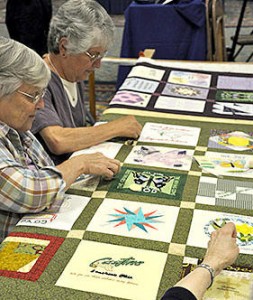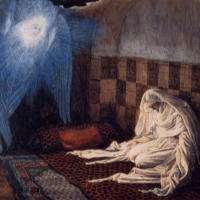In my early twenties I attended a conference sponsored by an enthusiastic movement which was flourishing in ecumenical Christian circles at the time. One of the workshop speakers was a Southern Baptist minister who had helped to found a large network of Christian communities which identified themselves as “non-denominational” churches. Born in Alabama and raised in an anti-Catholic home, over the years he had grown in his admiration of the Catholic Christian faith through his experiences with Catholics who truly loved the Lord and understood their faith. He had also become quite popular as a speaker in these ecumenical circles.
A friend encouraged me to select this workshop from among several offered during the morning hours of this conference. It was a memorable experience. The speaker’s love for – and familiarity with – the Christian Scriptures was inspiring. He had committed many to memory and the verses flowed naturally within the context of his teaching and preaching.
His style was inspiring. He passed back and forth from scripture to insight, much like the dynamic that is found in the writings of the early Church Fathers. This familiarity with the scriptures fanned a flame growing within me, a hunger to be immersed in God’s word in order to be more deeply converted through an encounter with the Living Word, Jesus Christ.
Having spent my own early childhood in Dorchester, Massachusetts, I was unfamiliar with Southern mannerisms and had quite a different cultural background. His accent, carriage and vocal cadence kept my attention and ensured that I heard the entire message. I also had a very different set of childhood experiences. He began his talk with a story from his rural Southern childhood which was filled with symbolic insight.
That story, which I heard close to forty years ago, has repeatedly come back to my mind as I have lived my very real life, filled as it has been with all the unexpected turns, disappointments, sorrows, struggles, failures and joys that are the stuff of human experience. I share it with you my reader, in the hopes that it can help you as well to believe there is a Divine Design in each of our lives being woven by the God who created us out of love and is recreating us anew through Jesus Christ.
The speakers’ mother had frequently taken him to southern “Quilting Bees” where local women would gather to display their quilts and work together on new ones. These experiences began when he was a toddler. The task of hand quilting involved the use of large wooden Quilting frames. His mother would place him on the grass to play while she participated in quilting.
He recalled crawling to the quilting frames where, from his vantage point as a small child, he could only see strands of thread, fabric and splashes of color hanging down between the wooden slats. He vividly recounted his experience on thatythat one special day when he was able to pull himself up on the side of the wooden frame and behold the beautiful design from above.
It was an epiphany moment. What had once been perceived by a toddler as strands of fabric, thread and splashes of color was actually revealed as an extraordinary tapestry. The quilter was an artist who had a beautiful design in mind from the beginning.
As the speaker grew older and could stand upright on his own, he was able to see those designs with less difficulty. He would never forget that moment of encounter as a toddler when he pulled himself up on the side of that Quilting frame.
The story served as a rich pictorial image and symbolic framework for his entire presentation. He opened up a deeper understanding of How the Lord works in our own lives. There is a Divine Design. From above, there is a pattern, being woven by God out of the fabric of our everyday lives. It is from below that this often appears as strands of thread and cloth. As we grow in faith and co-operate with grace, we are enabled to pull ourselves upright through our choices, our exercise of human freedom.
Living faith mediates the mystery of God’s loving plan and opens our spiritual eyes to behold the Divine Design.
This story, and the image that it conveys, has reemerged at pivotally important times in my own life. Let me be honest, life is often confusing – and pain is a part of the program. As I have aged, I have become more honest about all of this. In spite of your best efforts, things do not always go the way that you had hoped. The questions emerge at an ever deeper center, a core. Questions such as “how does this all make sense”?
The speaker shared another insight drawn from quilting. The quilter begins at a center point, with a patch of cloth that becomes the reference point from which he or she weaves the entire pattern of the quilt. From that center, the design emanates and to it, the design returns. It is also to that center that the eye is drawn when the whole quilt is observed from above.
For the Christian, the center from which the Divine design proceeds within the fabric of our own lives- and through which we begin to discern the beauty of God’s perfect plan – is the Cross of Jesus Christ. It is the central patch of cloth from which the pattern proceeds. It is also where the pattern returns. However, seeing this pattern requires ongoing conversion.
We need the renewed vision that can only come through living faith. We lso need the strength to pull ourselves up by grasping the wood of the Cross. It is only there where we begin to see that the threads all form a pattern woven by Love.
The Early Christian Fathers beautifully reflected upon the Cross in so many of their writings. The Cross was often presented as a “second tree” at which the new creation began again in Jesus Christ. On that Cross, the Living Word, through whom the Universe was created, re-created it all anew. One early monk, Theodore the Studite, an eighth century Abbot of the undivided Church of the First Christian Millennium, once proclaimed:
“How precious the gift of the cross, how splendid to contemplate! In the cross there is no mingling of good and evil, as in the tree of paradise: it is wholly beautiful to behold and good to taste. The fruit of this tree is not death but life, not darkness but light. This tree does not cast us out of paradise, but opens the way for our return.
“This was the tree on which Christ, like a King on a chariot, destroyed the devil, the Lord of death, and freed the human race from his tyranny. This was the tree upon which the Lord, like a brave warrior wounded in hands, feet and side, healed the wounds of sin that the evil serpent had inflicted on our nature.
“A tree once caused our death but now a tree brings life. Once deceived by a tree, we have now repelled the cunning serpent by a tree. What an astonishing transformation! That death should become life, that decay should become immortality- that shame should become glory!”
A Deacon of that undivided Church named Ephrem lived in the fourth century in Edessa, Syria. He was in love with this wounded warrior of Love, Jesus Christ. He, with his inspired preaching, proclaimed the truth of this Divine design. He also wrote extraordinary hymns which gained him a title, still mentioned in the Syriac Liturgy to this day — “the Harp of the Holy Spirit”. In one of his powerful sermons, Deacon Ephrem wrote these words concerning the Cross:
“He who was also the carpenters glorious son set up his cross above deaths’ all consuming jaws, and led the human race into the dwelling place of life. Since a tree had brought about the downfall of mankind, it was upon a tree that mankind crossed over to the realm of life.
“Bitter was the branch that had once been grafted upon that ancient tree, but sweet the young shoot that has now been grafted in, the shoot in which we are meant to recognize the Lord whom no creature can resist. We give glory to you, Lord, who raised up your cross to span the jaws of death, like a bridge by which souls might pass from the region of the dead to the land of the living.
“We give glory to you who put on the body of a single mortal man and made it the source of life for every other mortal man. You are incontestably alive. Your murderers sowed your living body in the earth as farmers sow grain, but it sprang up and yielded an abundant harvest of men raised from the dead. Come then, my brothers and sisters, let us offer our Lord the great and all embracing sacrifice of our love and our lives”
So what do the story of the preacher and the message of these early Christian writers have in common?
In each of our own lives we will experience disappointment. We will suffer. We will make wrong choices. We will fail, and we will fall. We will experience the consequences. The sheer weight of the “stuff of life” can sometimes reduce us to figuratively crawling. However, whether we see it or not at the time, there really is a Divine Design. The way to standing back upright, and being able to discern the pattern, is living faith in Jesus Christ.
As we pull ourselves up on the frame of His Cross we can come to see that what once seemed to be strands, pieces of cloth, with no apparent pattern, are actually a part of this design being woven from the center. In Jesus Christ we can find the fullness of God’s plan. In Him –and through Him – and with Him- we are in the process of being recreated.
So too, is the whole universe. He is the center from which the pattern emanates and to which it will all return. There really is a Divine Design.


